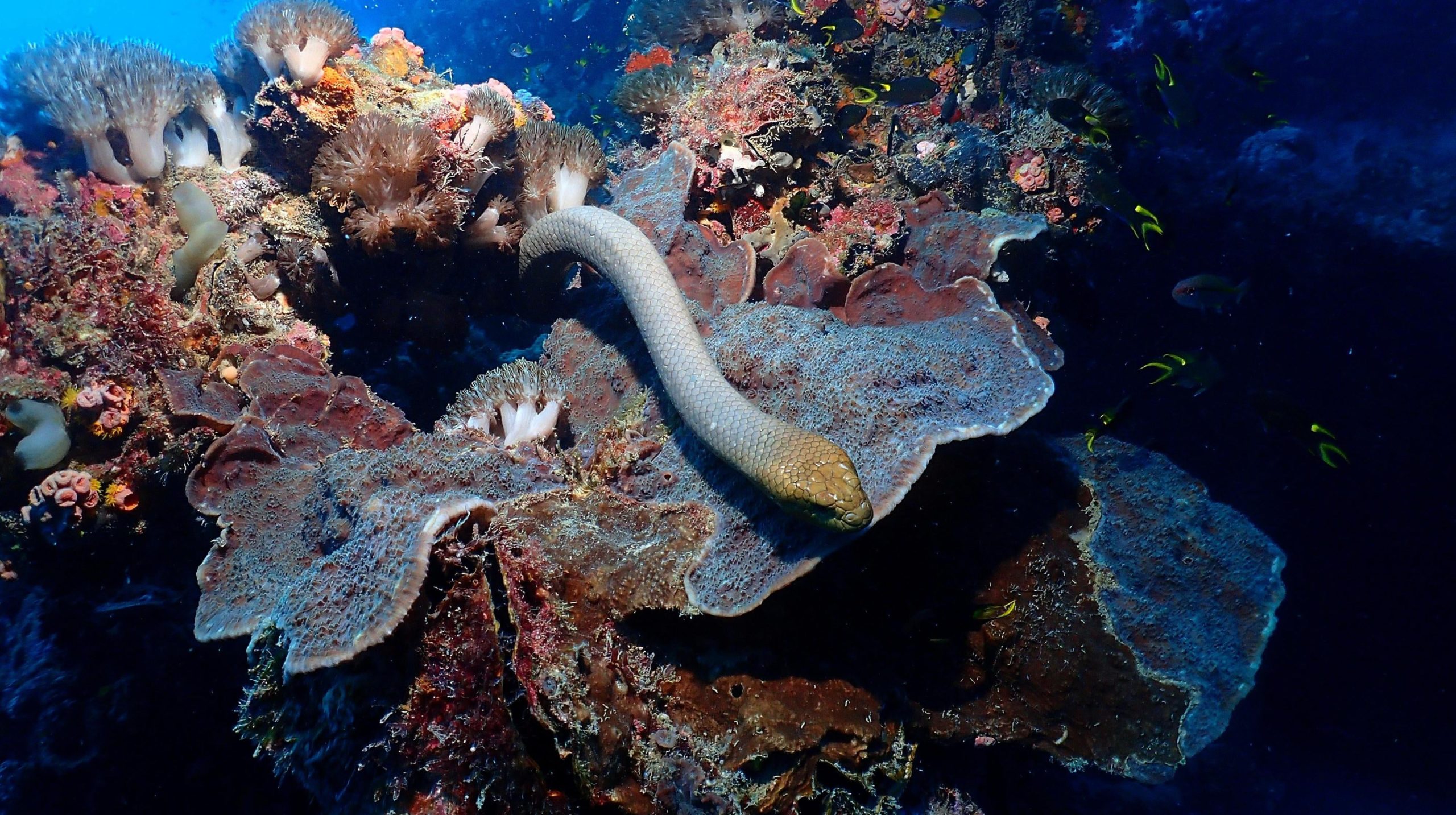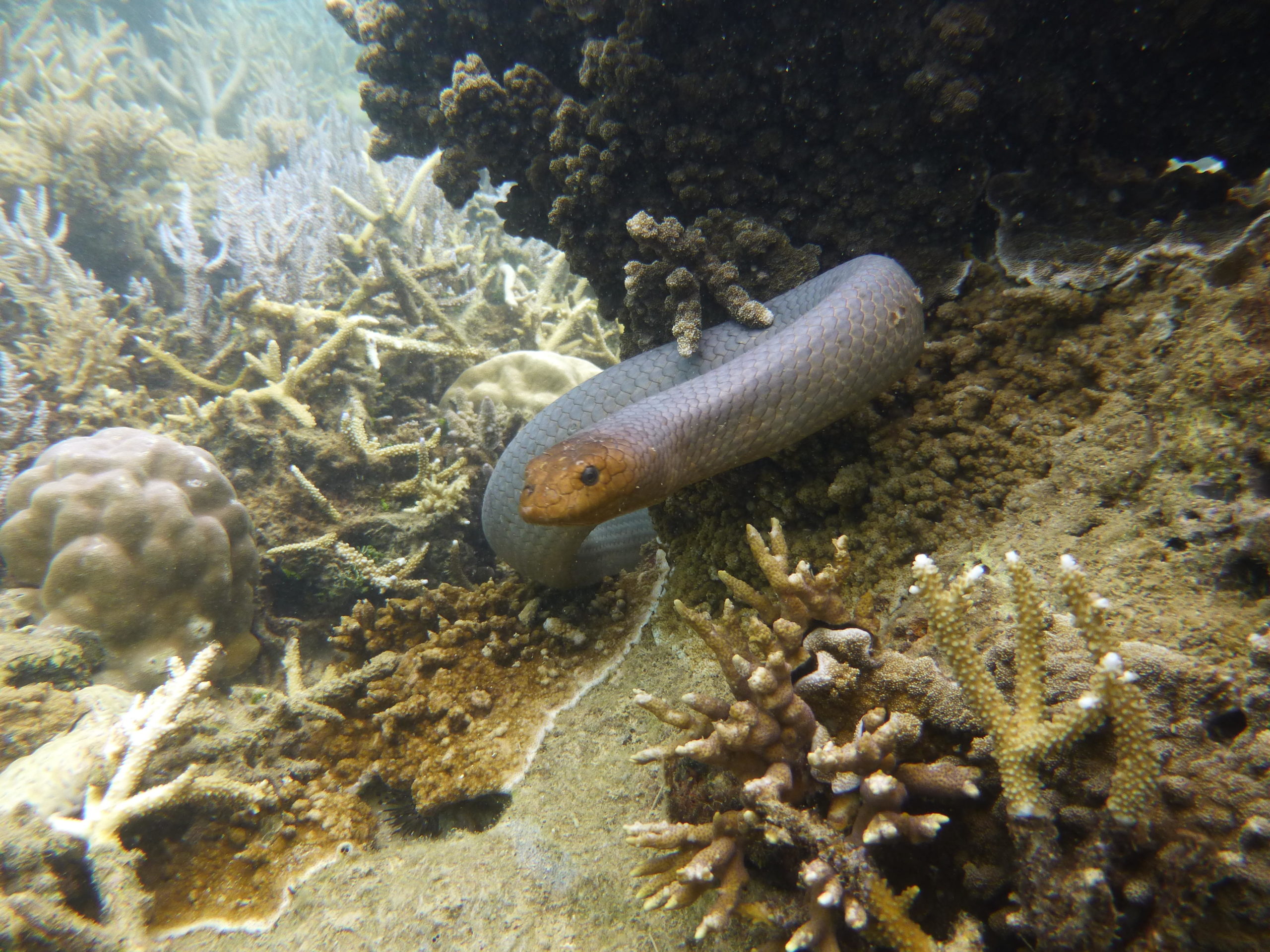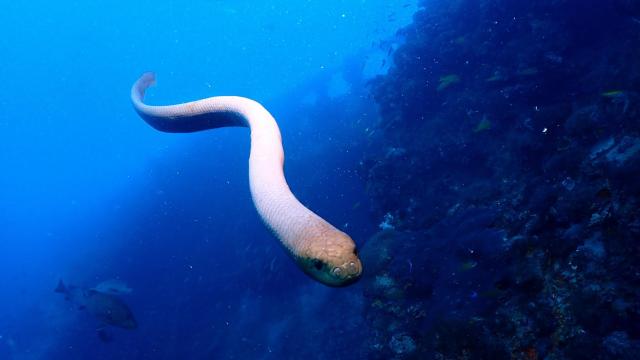Sea snakes are total nightmare fuel, but new research suggests their frequent “attacks” on scuba divers are in reality botched attempts to get lucky.
Many scuba divers who explore tropical coral reefs in Australia and New Guinea are all too familiar with the highly venomous Olive sea snake (Aipysurus laevis). These marine reptiles will often chase and attack divers without any provocation. These encounters can get scary in a real hurry, especially when a sea snake wraps itself around a diver’s leg or arm and chomps down.
Deaths from venomous bites are recorded annually, and they typically involve fishermen. Attacks on scuba divers are also reported, but even when sea snakes don’t bite, they can cause divers to panic, making an uncomfortable situation even worse. The reason for these unprovoked attacks isn’t fully understood, hence the importance of a new study, published today in Scientific Reports.
Ever since Richard Shine, a co-author of the new paper and a scientist at Macquarie University in Australia, began working with sea snakes, he’s wondered why these animals sometimes approach him, instead of swimming away.
“A high frequency of ‘attacks’ on divers by sea snakes has always puzzled me,” Shine explained in an email. “Why should a snake attack a person that is too big to eat and poses no threat?”

The new study was an attempt to answer this question. Data for the research was collected by study co-author Tim Lynch, a scuba diver and researcher with CSIRO. Lynch carefully recorded the behaviours of the serpents in the southern Great Barrier Reef, in what was a 27-month scuba-based investigation of sea snake ecology. Strangely, these observations were made between 1993 and 1995, prompting me to ask Shine why his team’s data is so old.
“You can blame COVID,” Shine replied sarcastically, as the global pandemic is actually what made this work possible. Lynch gathered the data for his PhD thesis in 2000, and Shine knew about the work and wanted to cite it in his own sea snake research. This data was never published in peer-reviewed literature, so “with some time on my hands when COVID made fieldwork impossible, I contacted Tim and we agreed to go ahead and write it up for publication together,” Shine explained.
As a research subject for a field study, the highly venomous Olive sea snake is formidable. They’re among the largest marine snake species, with adult females reaching 2 metres in length and weighing upwards of 3 kg. Males are only slightly smaller. These swimming snakes spend their entire lives underwater, are widespread in the tropical waters around Australia and New Guinea, and subsist on a broad diet consisting of snails, fish, and crustaceans. During their attacks on divers, the sea snakes make rapid and jerky zigzag movements, which is very unlike their normal swimming behaviour.
During the field sessions, Lynch was approached by sea snakes during 74 of 158 encounters. As they swam around him, the sea snakes often flicked their tongues near Lynch’s body. Males approached him more frequently than females and also hung out for longer periods of time.

Interactions happened most frequently from May through to August, which coincided with the sea snakes’ mating season. During the mating season, “males spend much of their time swimming rapidly along the reef edge and courting any females they encounter,” while females “often flee from these courtship attempts, by taking refuge within coral crevices or swimming away rapidly,” the researchers write in their study.
On 13 different occasions — all during mating season — sea snakes charged Lynch at high speeds. Disturbingly, males coiled themselves around his flippers on several occasions — a behaviour typically seen during sexual interactions.
“Agitated rapid approaches by males, easily interpreted as ‘attacks’, often occurred after a courting male lost contact with a female he was pursuing, after interactions between rival males, or when a diver tried to flee from a male,” according to the study.
Female sea snakes also charged at Lynch, but they only did this after having been chased by a male or after having lost track of a lustful male.
Taken together, these observations led the researchers to conclude that the seemingly aggressive sea snake behaviour is not what it seems.
“The so-called ‘attacks’ by Olive sea snakes are due to mistaken identity — usually occurring when a male sea snake is looking for females, or when a female is trying to escape the amorous attention of a male,” Shine explained.
Mistaking a human diver for a potential mate might seem ridiculous, but Shine says it’s hard to see underwater. It “seems that snakes find it hard to distinguish objects, so they approach anything interesting so that they can tongue-flick it to obtain more reliable scent cues.” As for the encounters involving female sea snakes, the scientists believe it’s yet another case of mistaken identity: The females are simply looking for a place to hide.
The new paper is really great, but I’ve got a couple of nit-picks. I’m sure the data is fine, but having multiple scuba divers collect the field study data would’ve been a good idea. Something about Lynch’s personal swimming style or physical form may have somehow altered the sea snake behaviour. Having more recent data to work with would’ve also been ideal, as observation techniques, among other aspects, may have improved over the years.
That said, the study provides an important lesson, as the findings could literally save a scuba diver’s life. As the paper points out, divers who “flee from snakes may inadvertently mimic the responses of female snakes to courtship, encouraging males to give chase,” so to “prevent escalation of encounters, divers should keep still and avoid retaliation.”
Heh, easier said than done, I’m sure — but helpful advice nonetheless.
